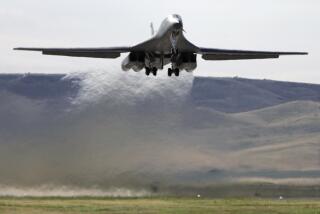Rockwell Says Cost of B-1 Program Will Run $100 Million Over Target
Rockwell International has notified the Air Force that its estimated cost to complete B-1 bomber production has increased by about $100 million over its original cost target and that it is setting up an additional $400-million reserve against potential future cost increases, the aerospace company confirmed Friday.
The cost increases, however, will not push the B-1 production cost over the amount that President Reagan certified to Congress when he launched the controversial bomber program over the protests of some congressional critics soon after he took office, Rockwell officials said.
“We believe that even with these additional costs, the total estimated program costs are well within the $20.5-billion (in 1982 dollars) ceiling placed on the B-1,” a company statement said. Rockwell officials said that a number of factors are responsible for the cost increase but that none of them is an indication of significant trouble in the program.
Harsher Evaluation
Spot delays in production and cost revisions on certain parts are typical reasons for the cost growth, a knowledgeable source said.
Throughout most of the B-1 program, Rockwell has been operating 10 weeks ahead of the delivery schedule called for under its contract, but in the past several months some of the air has gone out of that cushion, Rockwell officials acknowledged. They hope to restore the 10-week cushion by June 30, the source said.
A statement issued Friday by the Air Force said that Rockwell had exceeded its target cost by $500 million, suggesting a harsher evaluation of the cost growth.
But the statement appeared to play down the significance of the figures. “This is an estimate only. It constitutes a small percentage of the total Rockwell contract,” the statement said.
Nevertheless, the cost growth comes at a politically inopportune time because Rockwell is vigorously attempting to persuade the Pentagon to purchase more than the 100 B-1s now on order.
Rockwell President Robert Anderson recently offered Defense Secretary Caspar W. Weinberger additional B-1s at a sharp discount. Such a sale already faced substantial opposition from proponents of the competing Stealth bomber, now under development at Northrop.
The B-1 has been extolled by Pentagon officials as a model of efficiency because of Rockwell’s ability so far to meet a very rigorous delivery schedule and hold costs down to its budget. By late this year, Rockwell plans to be producing four aircraft per month, delivering an unprecedented $1.1 billion of aircraft monthly.
Flexible Contracts
While the cap on the B-1 set by President Reagan was $20.5 billion in 1982 dollars, inflation is expected to drive up the program’s cost to $28.5 billion by April, 1988 when scheduled production ends. That figure includes payments to Rockwell and other contractors on the project as well as the Air Force’s in-house costs.
Rockwell’s B-1 contracts are flexible, having a target production cost and a ceiling. The target on the B-1 contracts is about $12.3 billion, and the ceiling is $16 billion, industry sources said.
Under its “fixed-price incentive contract,” Rockwell absorbs 20% of any cost increases over the target cost and the Air Force absorbs 80%. Costs over the ceiling are paid totally by Rockwell.
No Effect on Profits
Thus, a $500-million cost growth would cut Rockwell revenue by $100 million, and the Air Force would absorb $400 million in additional costs. But Rockwell denied that any cost increases would affect profits.
“Since we have been booking our B-1B earnings conservatively, this new estimate will not affect reported profits,” the Rockwell statement said.
The cost increase was disclosed in a report by Joseph Campbell, an aerospace analyst at Paine Webber. Campbell did not reduce his earnings estimate for Rockwell in the report. The B-1, Campbell wrote, “probably will be the only major DOD (Department of Defense) program ever to come in at the forecast level.”
More to Read
Inside the business of entertainment
The Wide Shot brings you news, analysis and insights on everything from streaming wars to production — and what it all means for the future.
You may occasionally receive promotional content from the Los Angeles Times.










